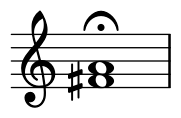Henry Lowengard left a comment on my post Phone tones in musical notation mentioning dial tones and busy signals, so I looked these up.
Tones
According to this page, a dial tone in DTMF [1] is a chord of two sine waves at 350 Hz and 440 Hz. In musical notation:

According to the same page, a busy signal is a combination of 480 Hz and 620 Hz with pulses of 1/2 second.

Note that the bottom note is an B half flat, i.e. midway between a B and a B flat, denoted by the backward flat sign. The previous post on DTMF tones also used quarter tone notation because the frequencies don’t align well with a conventional chromatic scale. The frequencies were chosen to be easy to demodulate rather than to be musically in tune.
Audio files
Here are audio files corresponding to the notation above.
Lilypond code for music
Here is the Lilypond code that was used to make the images above.
\begin{lilypond}
\new Staff \with { \omit TimeSignature} {
\relative c'{ 1 \fermata | }
}
\new Staff {
\tempo 4 = 120
\relative c''{
<beh dis> r4 <beh dis> r4 | <beh dis> r4 <beh dis> r4 |
}
}
\end{lilypond}
Related posts
[1] Dual-tone multi-frequency signaling, trademarked as Touch-Tone

Ha! Just wondered if you were using Lilypond for the oddball accidentals… and then you provide the source code! (Though now that I look at it again, that’s actually Lilypond embedded in TeX, no?)
For the dial tone, I think you want an F natural: F4 is 349.23 Hz. That said, unless there is some strange psychoacoustic or undertone thing going on, the dial tone clearly sounds like an F3, so more like 175 Hz. It’s a fairly well-known thing among guitarists that if you don’t have a tuner nearby, you can pick up a phone and tune your first fret on the low E string, which is an F3. (This hearkens to an era when landlines were plentiful, and we didn’t have supercomputers in our pockets with tuner apps.)
Ack, correction to my previous comment: The dial tone sounds like F2, *two* octaves below the documented frequency of 350 Hz, so more like 87 Hz.